- NPR: Nasa procedural Requirements
2 Fundamentals of systems engineering
A system is the combination of elements that function together to satisfy a requirement. A system is composed by the knowledge, the personel, the hardware, the software, proccesses…The systems engineer is the responsible that the project satisfies the requirments of the customer. The systems engineer has a global view of the project and communicate, monitor and coordinate the tasks. Systems engineer is a project manager with the next tasks: Ensure the costs and the schedule is being followed, manage the team, manage the technical aspects. A systems engineer is a technical project manager, it verity the technical aspects of a project.
The proccesses and requirements of a Nasa systems engineer:
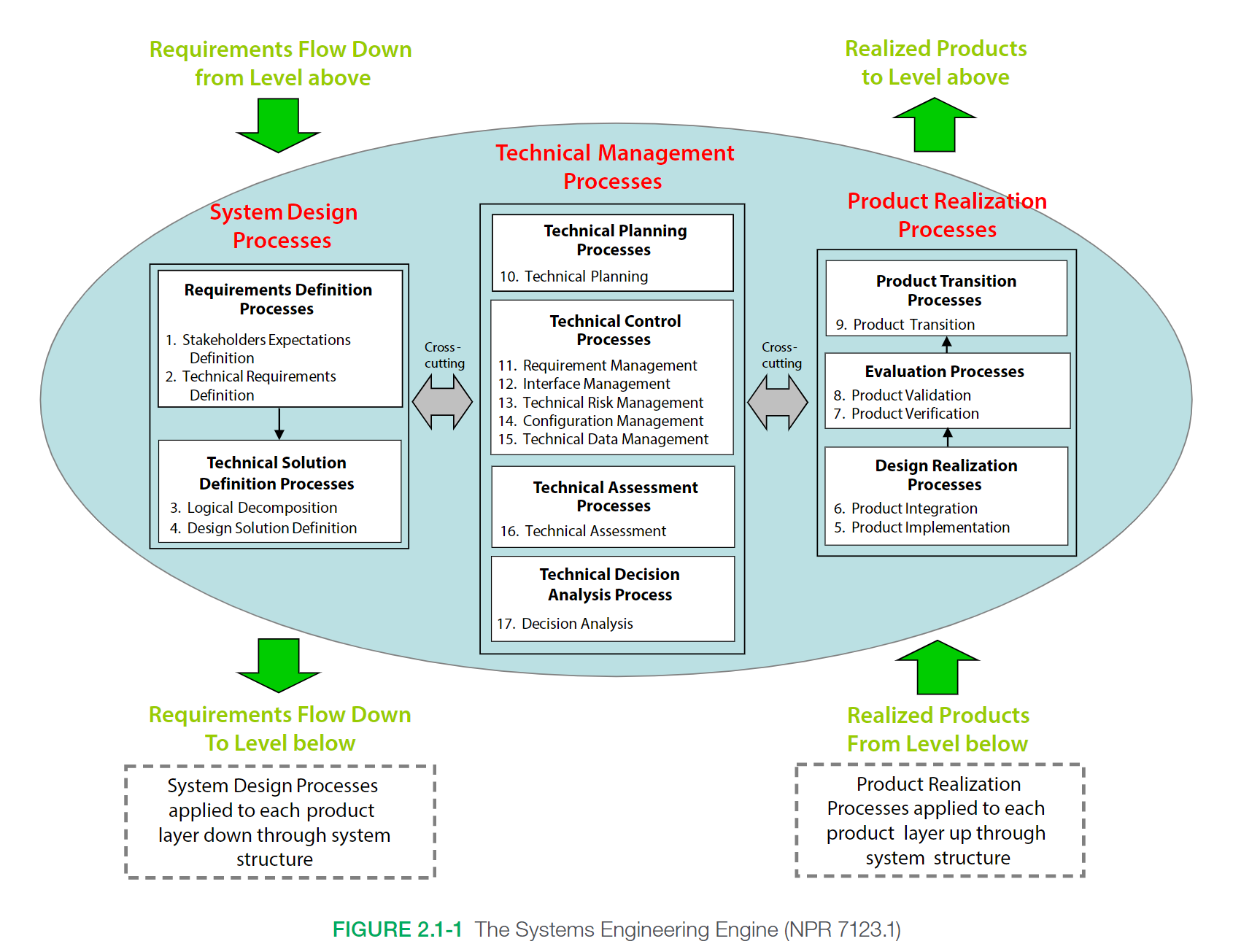
The system design processes are those that make the requirements of the curstomer into a design solution. The technical management processes are used to create the design solution, verify and validate. The product realization processes are to stablish the technocal plans for the project.
The phases of a space mission is showed in:

The phases are:
- Pre-Phase A - Concept Studies: Call to the science community to ideas for new missions. Determine the feasibility of the mission, develop mission concepts, identify potential technology needs. You see if it is feasible.
- Phase A - Concept & Technology Development: Study the feasibility and develop final mission concept, system-level requirements, study the technology developments for the mission. In the high risk parts you simulate and probe the concept.
- Phase B - Preliminary Design & Technology Completion: Create the initial baseline, with the firsts mission needs. Generate preliminary design for each subsystem. Perform verification and validation of concepts to ensure that the designs are able to meet their requirements.
- Phase C - Final Design & Fabrication
- Phase D - Systems Assembly, Integration & Test, Launch
- Phase E - Operations & Sustainment
- Phase F - Closeout
Important to clarify the difference between verification and validation:
- Verification of a product shows proff of compliance with requirements.
- Validation of a product shows that the product accomplishes the intended purpose in the intended environment.
Cost effectiveness considerations
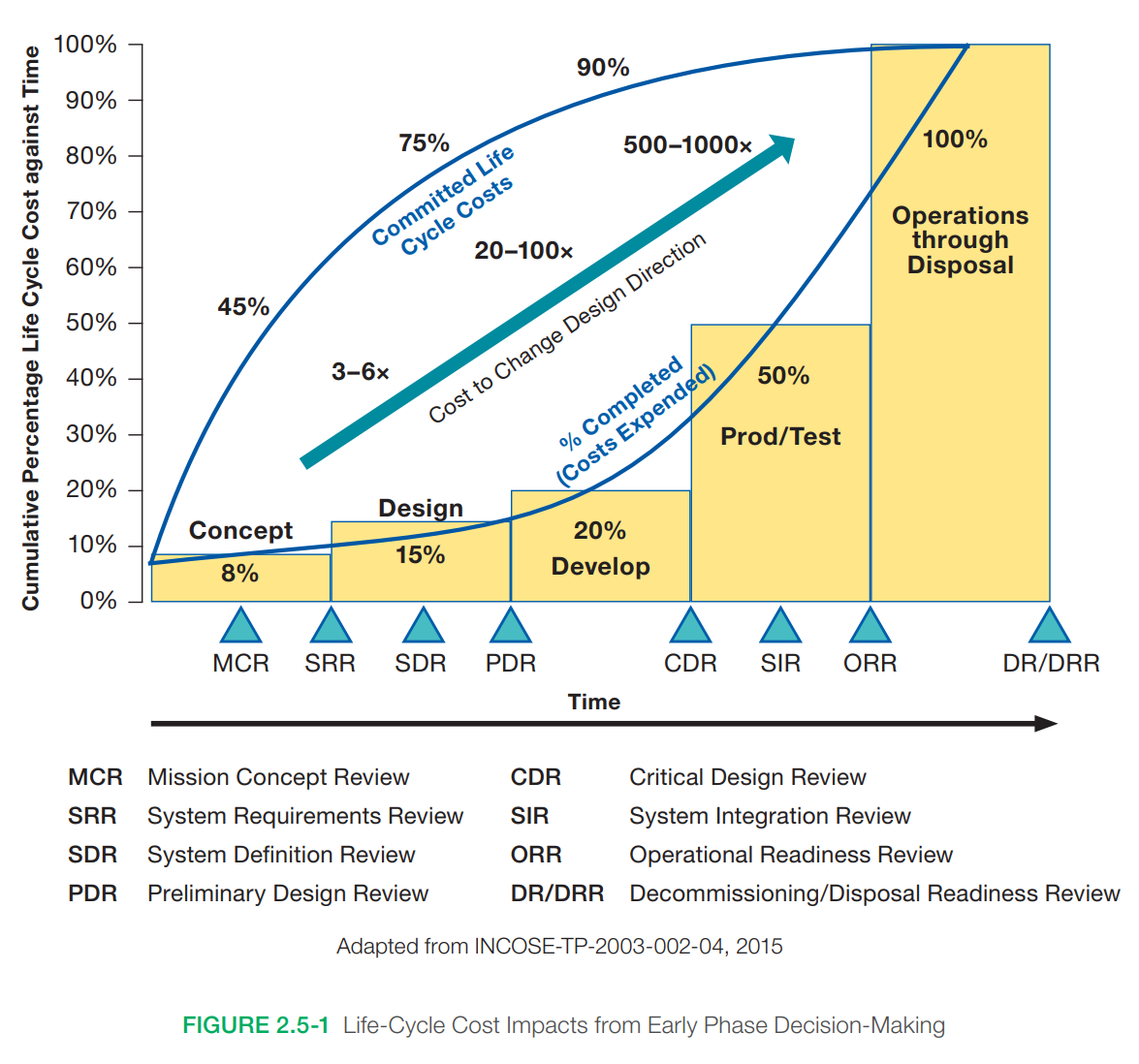
The committed costs are the costs that is planned, and the completed are the costs that are expended. During design about only 15% of the costs might be expended but the design itself will commit about 75% of the life cycle costs.
The competency model for systems engineers divides these competency areas:
- System Design. With these competencies:
- Stakeholder Expectation Definition & Management
- Technical Requirements Definition
- Logical Decomposition: transforming set of technical requirements into logical decomposition models and their associated set of derived technical requirements for lower levels of the systems.
- Design Solution Definition
- Product realization. With these competencies:
- Product implementation
- Product integration
- Product verification
- Product transition: Transitioning the verified and validated product to the customer at the next level of the system structure, this is storing, shipping generate documentation to accompany the product.
- Technical management. With these competencies:
- Technical planning
- Requirements management
- Interface management
- Technical risk management
- Configuration management
- Technical data management
- Technical assessment
- Technical decision analysis
3 NASA Program/Project Life Cycle
KDP (Key Decision Points) are the events at which the decision authority determines the readiness of a program/project to progress to the next phase of the life cycle. There are some phase boundaries that gives the answer of the decision.
NASA life-cycle models are described in in NPR 7120.5, NPR 7120.7, and NPR 7120.8. And it is described as 2:
- Formulation: From project Life-cycle phases it is Pre-phase A, Phase A, Phase B. Establishes a cost-effective program that is achiable, giving goals and objectives.
- Implementation: It is Phase C, Phase D, Phase E and Phase F. Execute the plan within funding constrains.
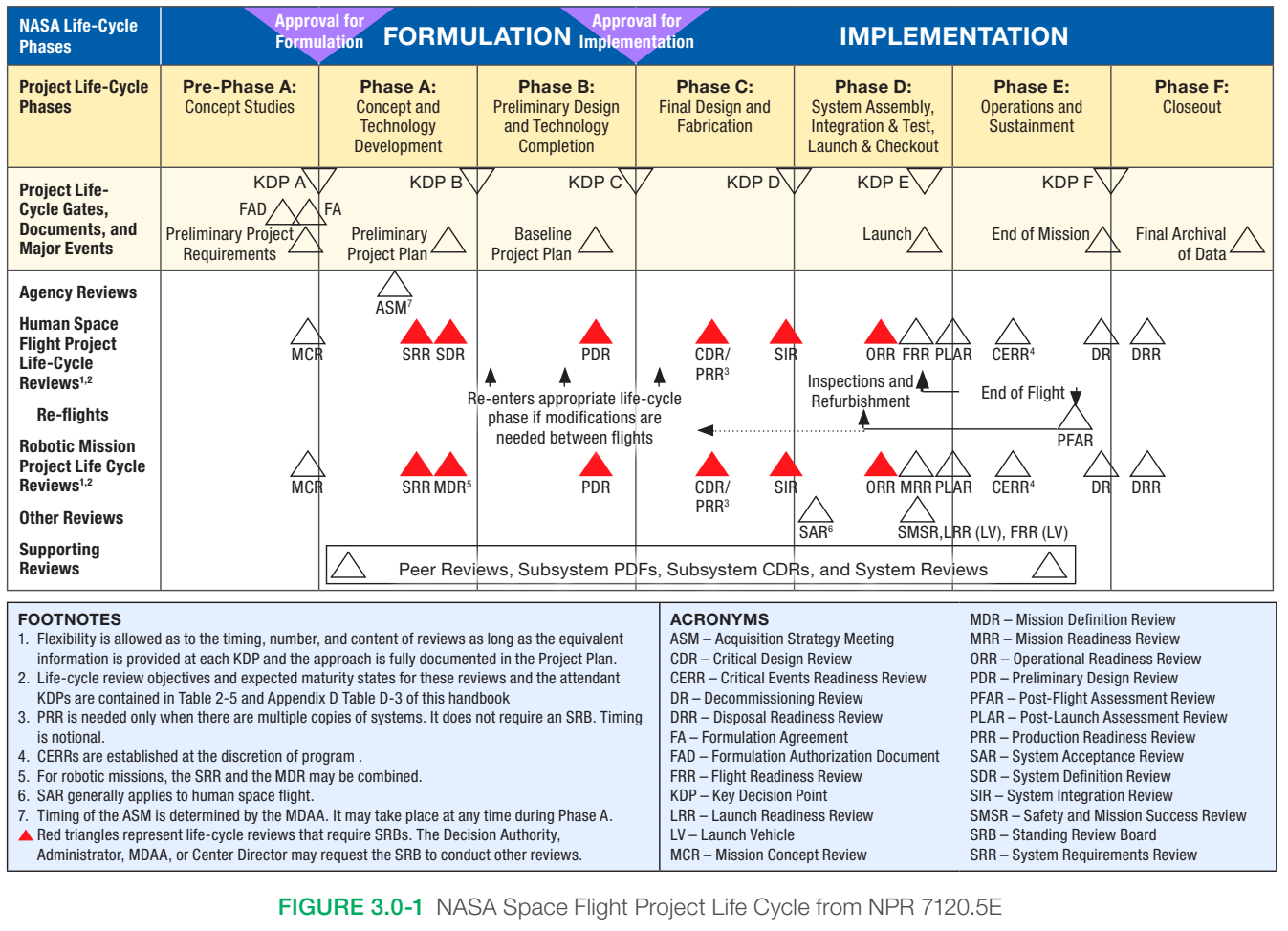
4 Systems Design Processes
This chapter describes the activities in this picture:

I don’t finally get the relation between the SE engine and the system design processes.
There are four system design processes: developing stakeholder expectations, technical requirements, logical decompositions, and design solutions.
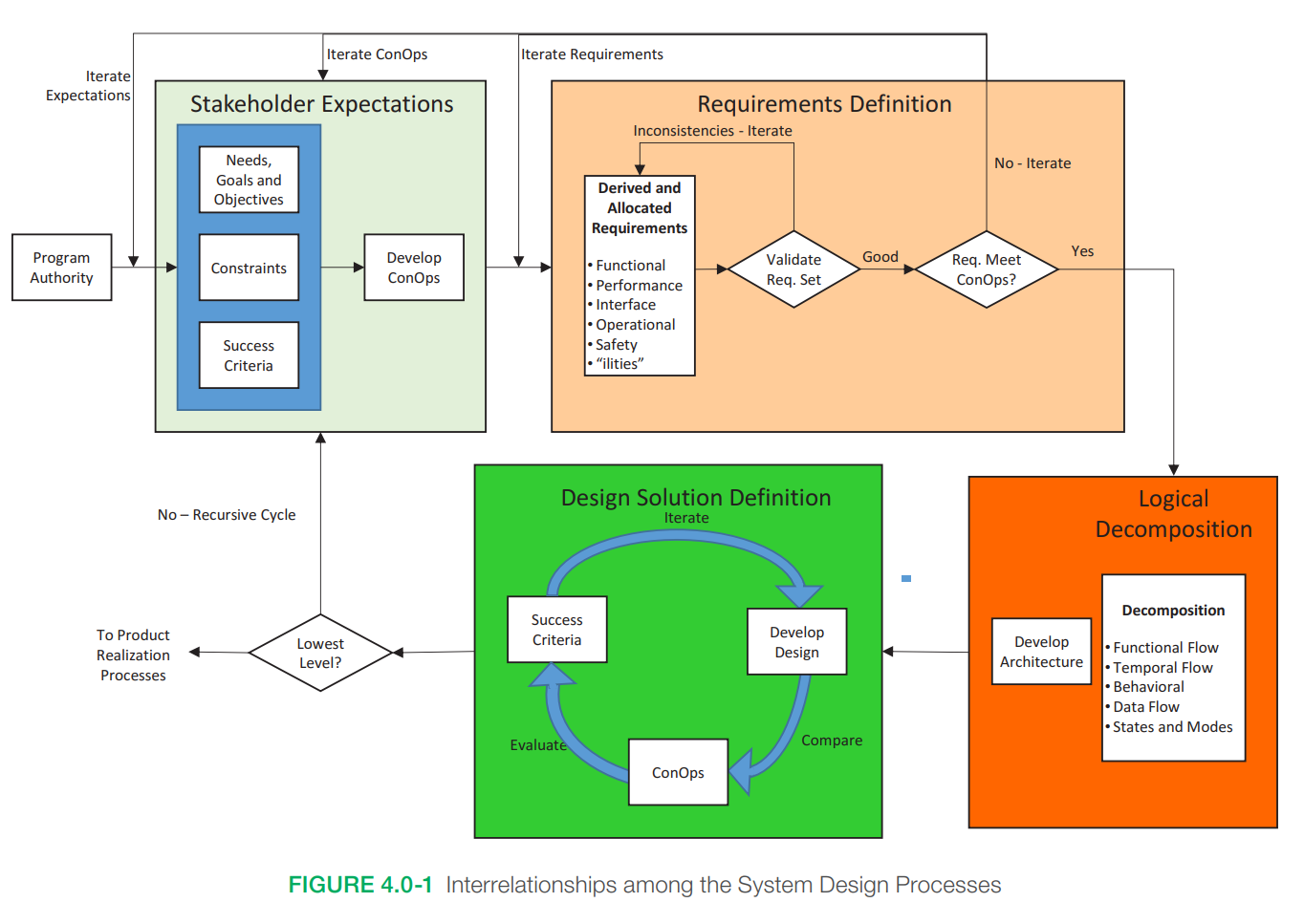
Stakeholder expectations
Is the initial procvess of the SE engine which defines the motivation of the project. A stakeholder is a group or individual that is affected by or has a stake in the product of project. The key stakeholders is the customer. The stakeholder expectations will give the high-level requirements of the mission.
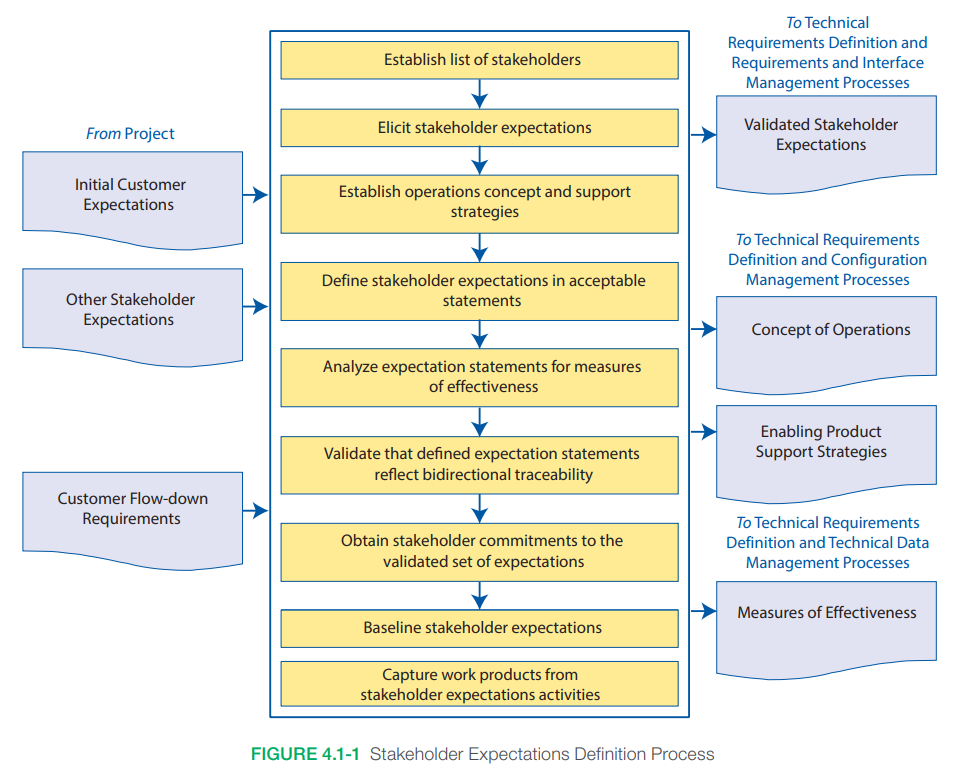
In order to define the goals and objectives it is neccessary to elicit the needs, goals and objectives (NGOs).:
- Needs: “What problem are we trying to solve?”
- Goals address what must be done to meet the needs
- Objectives expand on the goals and provide a means to document specific expectations
After the initial stakeholders expectations, the development of a concept of operations (ConOps) will further ensure that the technical team fully understand the expectations. The ConOps defines the overall high-level concept of how the system will be used to meet stakeholder expectations, it describes the system from an operational perspective.
Technical Requirements definition
The technical requirements definition process transform the stakeholder expectations into a definition of the problem and then into a complete set of validated technical requirements expressed as “shall” statements.
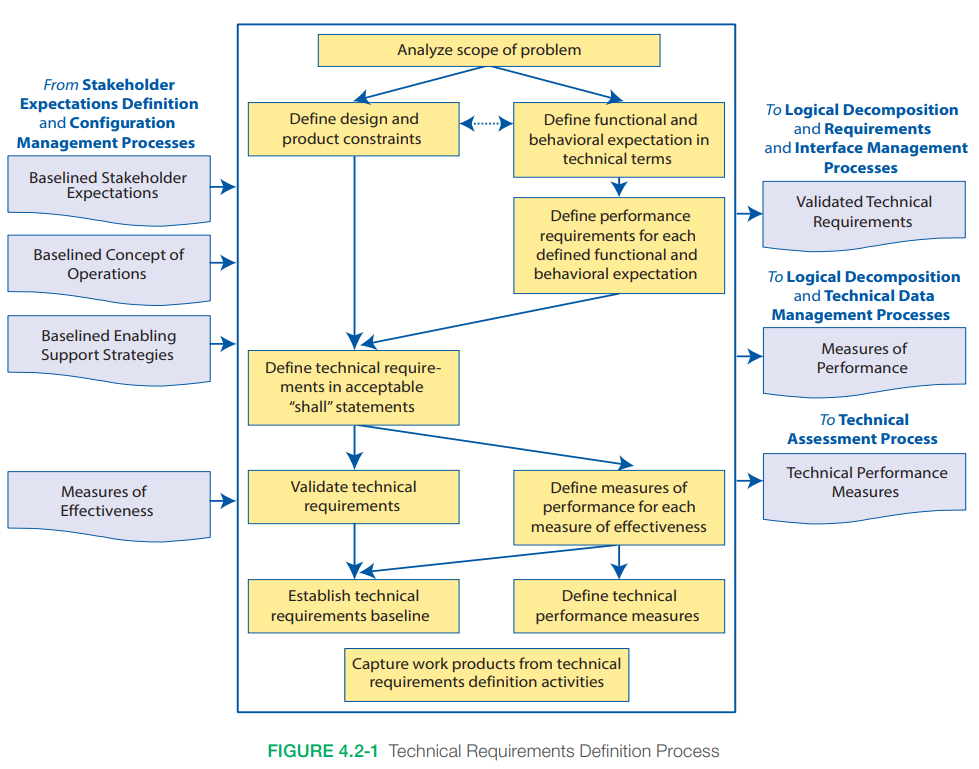
Differences between functional and performance requirements:
- Functional requirements define what functions need to be performed to accomplish the objectives.
- Performance requirements define how well the system needs to perform the functions
A requirement should in the format:
- Requirement ID: unique
- Requirement itself
- Rationale: clarify the intent of the requirements at the time they were written
- Traced from: Bidirectional traceability between parent requirements and lower level (derived) requirements.
- Owner: Person or group responsible for writing, managing, and approving changes to this requirement.
- Verification method: Captures the method of verification.
- Verification lead
- Verification level: System level, subsystem level etc.
It is neccessary to validate the requirements. These are the six steps:
- Are the requirements written correctly?
- Are the requirements technically correct?
- Do the requirements satisfy stakeholders?
- Are the requirements feasible?
- Are the requirements verifiable?
- Are the requirements redundant or over-specified?
It is neccessary to define MOP (Measures of performance) and TPMs (Technical Performance Measures). MOPs define the performance characteristics that the system should exhibit when fielded and operated in its intended environment. TPMs are physical or functional characteristics of the system associated with or established from the MOPs that are deemed critical or key to mission success.
Logical decomposition
Logical decomposition is the process for creating the detailed functional requirements. Create a system architecture and to decompose top-level requirements and allocate them down to the lowest desired levels of the project.
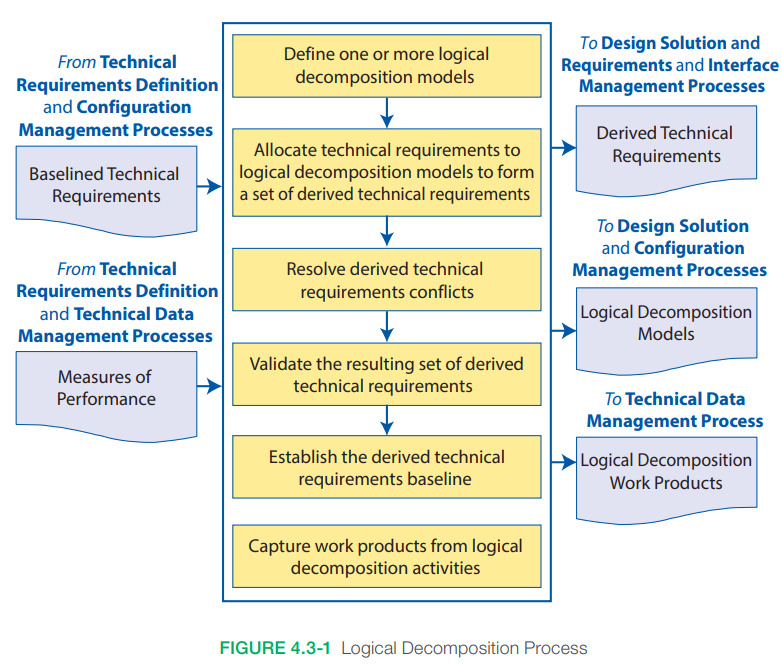
Design Solution Definition
It translate the high-level requirements derived from the stakeholdres expectations and the outputs of the logical decomposition process into a design solution.
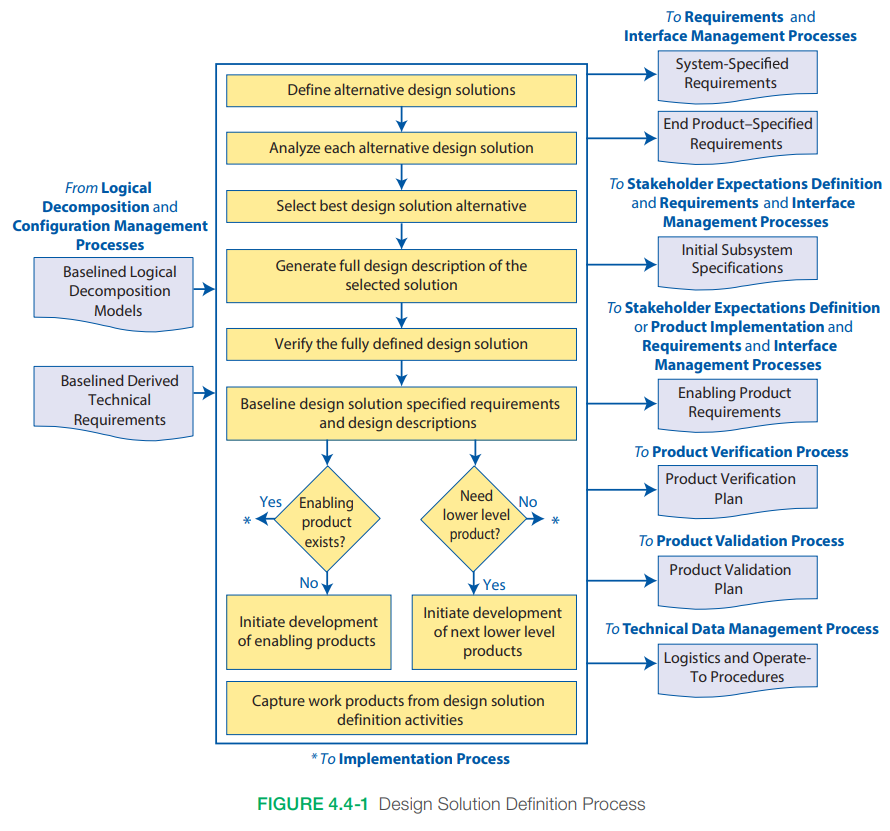
It is a design loop driven by the set of stakeholder expectations where a straw man architecture/design, the associated conops and the derived requirements are developed and constraints are considered. It is a loop of iterations in which there are design decisions to achieve a consistent product.
Pre-phase A: Concept studies
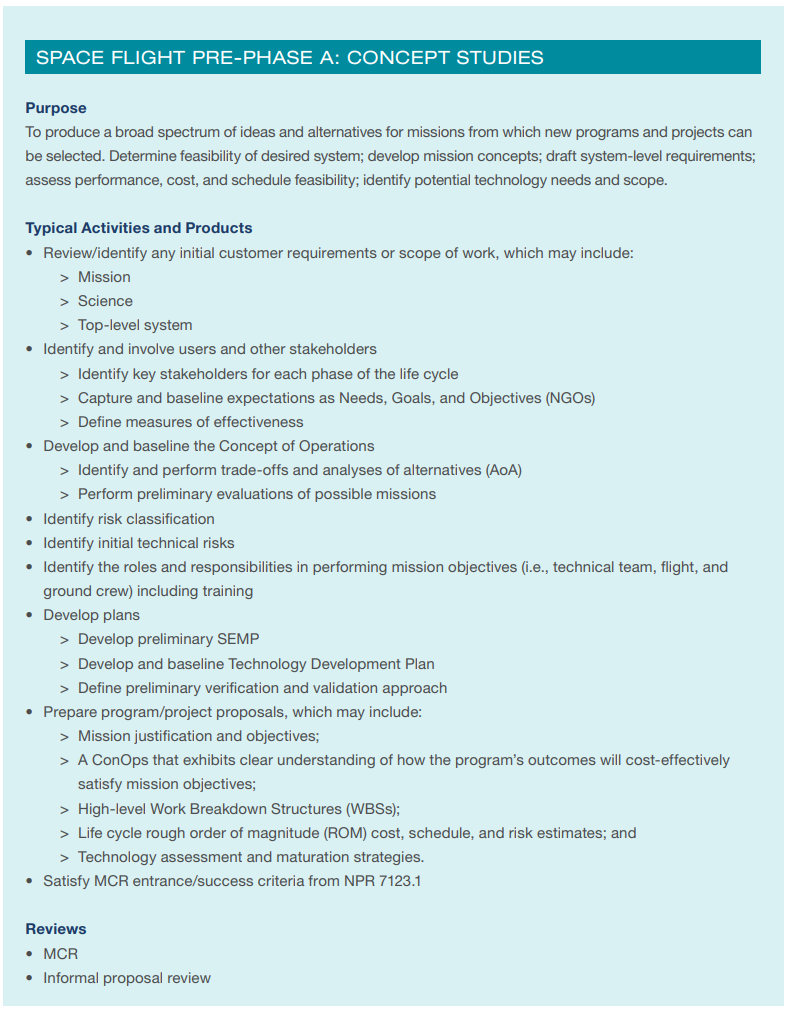
Main points in the Pre-phase A:
- Mission Concept Review
- Stakeholder identification
- Concept definition
- Measure effectiveness definition
- Inital cost and schedule for technical
- Preliminary requirements
- Approach of Verification and validation plans
The technical plans developed in this phase are:
- Preliminary SEMP
- Baseline technology development plan
- Approach review plan
- Approach verification and validation plan
Phase A
Main points in phase A.:
- Updated stakeholder identification
- Updated concept definition
- Update cost and schedule for technical
- Requierments
- Technical performance measures definition
- Architecture definition
- Allocation of requirements to next lower level
- Initial required leading indicator trends
- Design solution definition
- Interface definitions
- Implementation plans (Make/code, buym reuse)
- Integration plans
- Verification and validation results
Technical plans developed in this phase are:
- SEMP
- Risk management plan
- Preliminary integrated logistics support plan
- Updated technology development plan
- Update review plan
- Preliminary verification and validation plan
- Integration Plan
- Configuration Management Plan
- Data management plan….